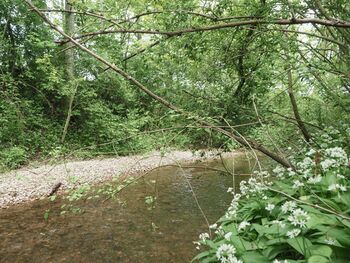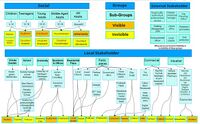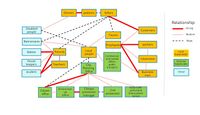LED2LEAP 2021 - Nürtingen Team 4
>>>back to working groups overview
For help with editing this Wiki page use this link.
For assignments and key readings use this link.
| Area | Area | |
| Place | Nürtingen | |
| Country | Germany | |
| Topics | blank | |
| Author(s) | Arash, Ekbal, Mohadese, Samira, Yuga | |
 Tiefenbach Tiefenbach
| ||
Landscape Democracy Rationale
Overcoming the flooding is One of the biggest challenges of the Neckar River, especially one of its tributaries, Tiefenbach. Due to urban development and other factors, many parts of the river have changed and are out of their original form. This region has many cultural and social potentials that can be developed in the desired direction by planning. Our main goal is participatory design using democracy .
Location and Scope
The study area of the project is located in the north of Nürtingen, Germany. Our focus is on the Tiefenbach River side near the city center. The project borders Bismarck Strasse from the north, the Neckar River from the west, Neckarsteige from the south, and Kanaistrasse from the east.
Phase A: Mapping Your Community
Welcome to Your Community and Their Landscape
Most of the buildings in this area are residential houses. There are also a number of special characters, including several schools, HFWU University, a church, several public buildings, an industrial building, and a central train station. There are some democracy challenges such as Private property of Groups, Interference in the interests of each group, Interference in the profits of each group. Also there are some landscape challenges in this area such as, Low Biodiversity, No Natural river side, No Access to the River, Risk of Flood. We can consider the risk of flood as the most important issue in this area.
Groups of Actors and Stakeholders in Your Community
There are three main groups in our range, including social group, local stakeholder and External stakeholder, which includes subgroups. For example, social subgroups are: Children, Teenagers, Young Adults, Middle-Aged Adults, old Adults. Also for all these subgroups, disabled people are considered. Local stakeholder subgroups are divided into several categories based on the type of characters, for example students, teachers, sellers, costumers, employees, tourist,... . Finally, the external stakeholder subgroups are Road traffic authority & enforcement service, Climate protection manager, City Planning Office, Building Management GW, citizen office, Business promotion, Environmental officer, Local council and Civil protection. Regarding the visibility of these groups, it can be said that the following groups are more visible: Students, Employed, Retirements, Customers, Local people, Parents and so on . Also, it is not possible to decide with certainty which External stakeholder are visible or invisible. Because of Corona situation we did not able to be present in the area. In this project, we divided the needs into two categories: specific needs of each group and common needs of all groups. for example one of the specific needs of parents, children and students is a recreational area near the river. The common needs of all groups in the study area around the Tiefenbach River are: Biodiversity conservation, River at ground level with a good view, Accessibility to the River, Natural river side, Air and water Quality and Flood safety. And finally an aspiration was created, derived from common needs: Ideal beach location next to Tiefenbach!
Relationships Between Your Actors and Groups
In this study, the relationship between groups is divided into three categories, strong, weak and moderate. For example, there is a strong connection between some groups, such as students and parents. Others, such as retirements and locals, have a moderate relationship with each other, and for poor communication, we can refer to the relationship between tourists and locals. The intensity and weakness of the relationship between the groups are shown in the graph in detail.
Summary of Your Learnings from the Transnational Discussion Panel
Learning from different idea from different student around the world and seeing their experience and visions was a great achievement for our group. And also it opens our perspective when we see other examples and challenges .
Theory Reflection
We found out that Democracy can do these things to improve the landscape
- Awareness of people against the concept and improvement of Landscape
- Clarification of differences in taste and culture in different groups
- Fair and equal participation of all segments of the people in improving the landscape
- Outline the main challenges of the environment and the development of Landscape
- Self-supporting local people financially and non-financially
- Direct or even indirect citizen participation to improve the landscape
What was difficult? For external stakeholders It was difficult to diagnose the power of their relationships because of THE PANDEMIC SITUATION. For all groups It was difficult to diagnose the exact shared interests between groups. What went well? Categorizing the groups and Identifying needs of social group and local stakeholders What did Surprised? The Needs of the groups were exactly same as the hypothesis of local landscape challenge.
References
https://www.nuertingen.de/de/nuertingen-fuer-alle/wirtschaft-handel/wirtschaft/standort
Kühne, Olaf (2015): Landscape Concepts
Council of Europe (2000):The European Landscape Convention
Phase B: Democratic Landscape Analysis and Assessment
Your Name and Partner's Name Correspondence
- ''insert text here''
Your Name and Partner's Name Correspondence
- ''insert text here''
Your Name and Partner's Name Correspondence
- ''insert text here''
Your Name and Partner's Name Correspondence
- ''insert text here''
Your Name and Partner's Name Correspondence
- ''insert text here''
Phase C: Collaborative Visioning and Goal Setting
The Scene in Your Story of Visioning
- insert text here
The Actors in Your Story of Visioning
- insert text here
The Story of Visioning
- insert text here
Reflect on Your Story of Visioning
- insert text here
Phase D: Collaborative Design, Transformation and Planning
Your Prototyping Action
- insert text here
The Evolution of Your Prototyping Action
- insert text here
The Plan Behind Your Prototyping Action
- insert text here
The Realization of Your Prototyping Action
- insert text here
Reflect on Your Prototyping Action
- insert text here
Phase E: Collaborative Evaluation and Future Agendas
Collaborative Evaluation and Landscape Democracy Reflection
- insert text here
The Actors in your Collaborative Evaluation
- insert text here
Reflection on the Online Seminar
- insert text here
Reflection on the Living Lab Process
- insert text here
Your Living Lab Code of Conduct
- insert text here
Process Reflection
- insert text here




















